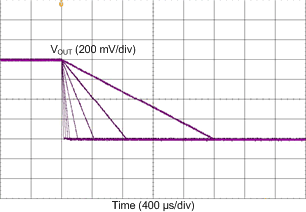SNVSBP2 February 2020 LP8758-E3
PRODUCTION DATA.
- 1 Features
- 2 Applications
- 3 Description
- 4 Revision History
- 5 Pin Configuration and Functions
- 6 Specifications
-
7 Detailed Description
- 7.1 Overview
- 7.2 Functional Block Diagram
- 7.3 Feature Description
- 7.4 Device Functional Modes
- 7.5 Programming
- 7.6
Register Maps
- 7.6.1
Register Descriptions
- 7.6.1.1 OTP_REV
- 7.6.1.2 BUCK0_CTRL1
- 7.6.1.3 BUCK0_CTRL2
- 7.6.1.4 BUCK1_CTRL1
- 7.6.1.5 BUCK1_CTRL2
- 7.6.1.6 BUCK2_CTRL1
- 7.6.1.7 BUCK2_CTRL2
- 7.6.1.8 BUCK3_CTRL1
- 7.6.1.9 BUCK3_CTRL2
- 7.6.1.10 BUCK0_VOUT
- 7.6.1.11 BUCK0_FLOOR_VOUT
- 7.6.1.12 BUCK1_VOUT
- 7.6.1.13 BUCK1_FLOOR_VOUT
- 7.6.1.14 BUCK2_VOUT
- 7.6.1.15 BUCK2_FLOOR_VOUT
- 7.6.1.16 BUCK3_VOUT
- 7.6.1.17 BUCK3_FLOOR_VOUT
- 7.6.1.18 BUCK0_DELAY
- 7.6.1.19 BUCK1_DELAY
- 7.6.1.20 BUCK2_DELAY
- 7.6.1.21 BUCK3_DELAY
- 7.6.1.22 RESET
- 7.6.1.23 CONFIG
- 7.6.1.24 INT_TOP
- 7.6.1.25 INT_BUCK_0_1
- 7.6.1.26 INT_BUCK_2_3
- 7.6.1.27 TOP_STAT
- 7.6.1.28 BUCK_0_1_STAT
- 7.6.1.29 BUCK_2_3_STAT
- 7.6.1.30 TOP_MASK
- 7.6.1.31 BUCK_0_1_MASK
- 7.6.1.32 BUCK_2_3_MASK
- 7.6.1.33 SEL_I_LOAD
- 7.6.1.34 I_LOAD_2
- 7.6.1.35 I_LOAD_1
- 7.6.1
Register Descriptions
- 8 Application and Implementation
- 9 Power Supply Recommendations
- 10Layout
- 11Device and Documentation Support
- 12Mechanical, Packaging, and Orderable Information
Package Options
Mechanical Data (Package|Pins)
- YFF|35
Thermal pad, mechanical data (Package|Pins)
Orderable Information
8.2.3 Application Curves
Measurements are done using typical application set up with connections shown in Figure 19. Graphs may not reflect the OTP default settings. Unless otherwise specified: VIN = 3.7 V, V(NRST) = 1.8 V, TA = 25 °C, ƒSW = 3 MHz, L = 470 nH (TDK VLS252010HBX-R47M), ILIM FWD set to maximum 5 A.
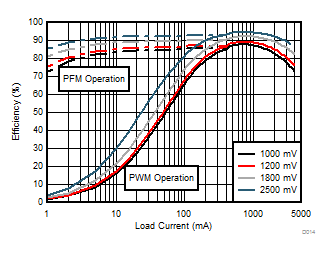
| VIN = 3.7 V | ||
| VOUT settings = 1000 mV, 1200 mV, 1800 mV, and 2500 mV | ||
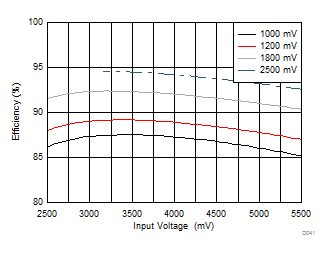
| Load = 1A | |||
| VOUT settings = 1000 mV, 1200 mV, 1800 mV, and 2500 mV | |||
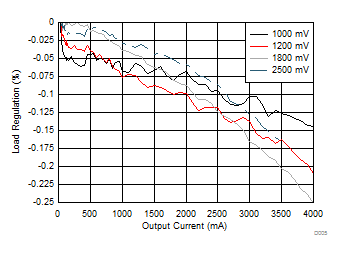
| Change in Output Voltage from Zero Load (%) | ||
| VOUT settings = 1000 mV, 1200 mV, 1800 mV, and 2500 mV | ||
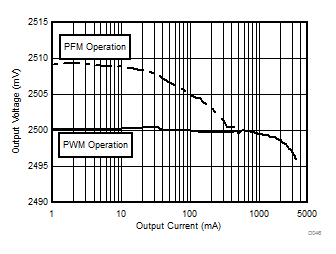
| VOUT setting = 2500 mV | ||
PWM-PFM Mode
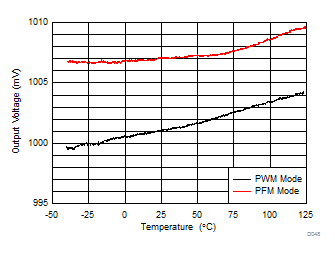
| VOUT setting = 1000 mV | ||
| Load = 1 A (PWM Mode) and 100 mA (PFM Mode) | ||
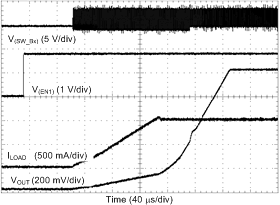
| Load = 1 A |
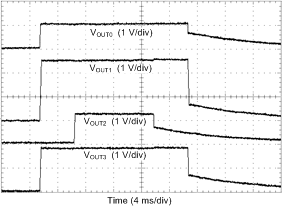
| Load = 0 A | Enable and disable delays = default | |
| VOUT settings = default | ||
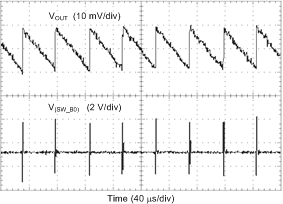
| Load = 10 mA |
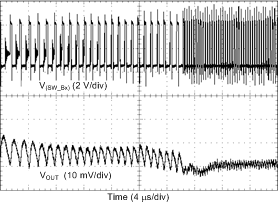
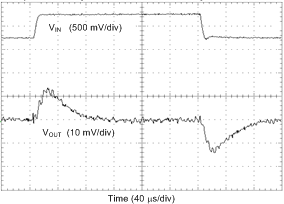
| Load = 4 A | VOUT = 1000 mV | |
| VIN stepping 3.3 V ↔ 3.8 V, TR = TF = 10 µs | ||
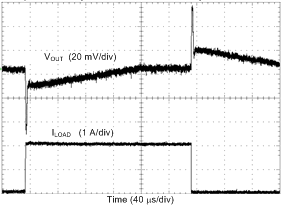
| Load = 0 A → 2 A → 0 A | TR = TF = 400 ns | VOUT = 1 V |
Forced PWM Mode
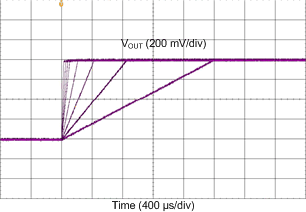
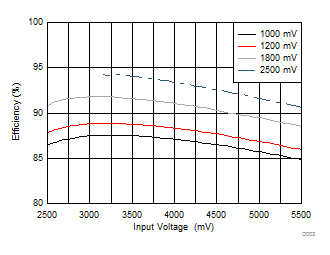
| Load = 100 mA | ||
| VOUT settings = 1000 mV, 1200 mV, 1800 mV, and 2500 mV | ||
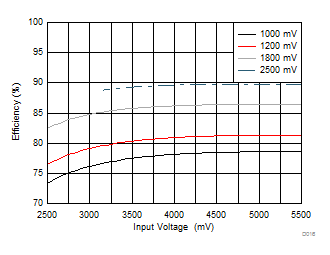
| Load = 3A | ||
| VOUT settings = 1000 mV, 1200 mV, 1800 mV, and 2500 mV | ||
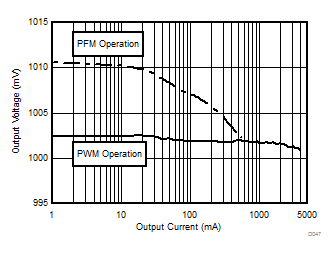
| VOUT setting = 1000 mV | ||
PWM-PFM Mode
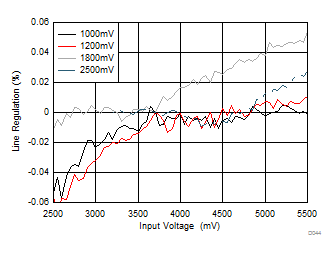
| Change in Output Voltage from VIN = 3.7 V (%) | Load = 1 A | |
| VOUT settings = 1000 mV, 1200 mV, 1800 mV, and 2500 mV | ||
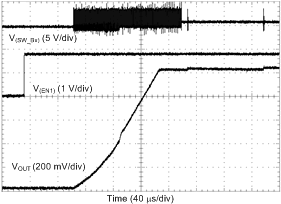
| Load = 0 A | ||
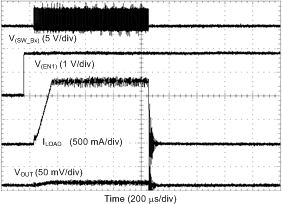
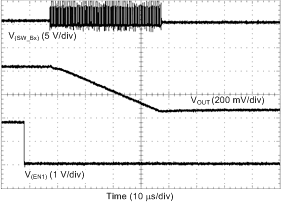
| Load = 0 A | ||
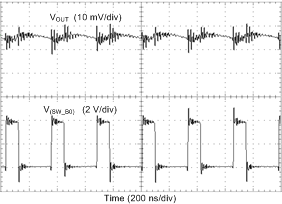
| Load = 200 mA |
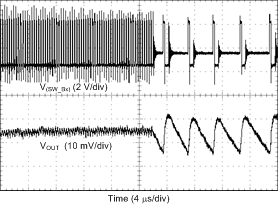
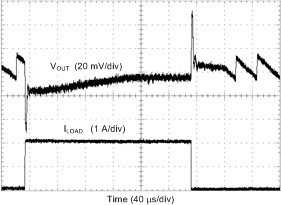
| Load = 0 A → 2 A → 0 A | TR = TF = 400 ns | VOUT = 1 V |
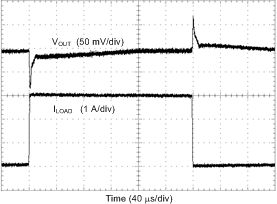
| Load = 1A → 4 A → 1A | TR = TF = 1 µs | VOUT = 1 V |
Forced PWM Mode
